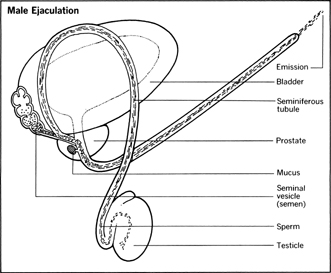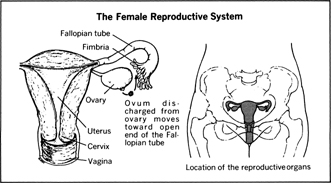Family Planning - Conception
Once you decide that you would like to have a child, planning the pregnancy involves two basic schedules. The first is deciding when you want the child to arrive. This includes deciding when pregnancy would be convenient. The second is discovering when fertility occurs each month in the woman's cycle.
When to Get Pregnant
In deciding when the best time of the year to have a baby arrive, several things should be taken into account. If you plan on taking time off from work for the child, you should consider the work you do and when a break in the work load would prove easiest to pull away. If you are a teacher, summer months may provide an ideal time for birth. If you can schedule delivery in June, the baby will be almost three months old before you start back to school in the fall. For others, a sabbatical or independent project may be timed to coincide with periods at home.
Weather may also help you decide when you wish to get pregnant. Buying winter clothing for the last stage of pregnancy can be costly. Getting a winter coat, and sweaters, and longjohns to fit during the eighth and ninth month of pregnancy may require buying clothes you won't ever wear again. Getting summer dresses and cotton pants for the last trimester of the pregnancy may be cheaper. Some women, however, cannot bear the thought of being eight months pregnant in the August heat.
Holiday schedules are also important. Some children love having birthdays around Christmas and Hanukkah. Other children hate it, feeling that their birthdays are overlooked in the festivities of the season. Pre-holiday births may allow a family to see distant relatives without taking an added trip across the country. For parents who work, holiday births may allow them to spend vacation time with their newborn.
Each family works on a slightly different schedule than the next. Their needs and what works best for them have to be determined on an individual basis. Even within that family, schedules may shift between the birth of one child and the next. Planning can help ease the burden of time off and child care that may be essential to making a family work.
How to Get Pregnant
Once you have decided on starting or continuing a family, planning the pregnancy involves calculating the fertile period in the menstrual cycle. For some parents, this requires no effort at all. Some women get pregnant immediately after stopping birth control. For others, months of timing ovulation may be required for successful conception.
The best method to figure out an ovulation cycle is to work with your physician. There are some things you can do in advance to help, though. Write down the starting and ending date of your period, for several months. If anything significant happens during the month that may have changed the cycle, such as an illness, note it in your calendar.
Your physician can give your specific information on physical characteristics and signs of ovulation that you should watch for. Basal body temperature fluctuates just before ovulation. If you chart your temperature every day at the same time, usually first thing in the morning, you should notice a slight change in the body temperature approximately two weeks before your period. The rise in temperature of about .4 to .8 degrees Fahrenheit appears normally within 24 hours of ovulation. It should last a few days and then the temperature should return to a normal level.
Some women do not get a sharp increase in temperature. It may be more subtle, more gradual, or even may drop in temperature slightly. It is important that you chart more than a couple months to get a better general view of your own body's rhythm.
Checking the viscosity of mucous production can also give some signs of ovulation. Cervical mucous production becomes more transparent and more elastic as ovulation occurs. There are also physical characteristic changes that can be noted under a microscope.
By establishing and keeping a calendar for these changes, a woman should be able to, with the help of her obstetrician or gynecologist, determine when she is fertile. If, after several months of intercourse during periods of fertility, the couple still has not conceived, the physician will recommend testing for egg and sperm production.
The Menstrual Cycle
The menstrual cycle runs, on average, every 28 days. As many women have cycles longer than 28 days as have cycles shorter than 28 days. Some women's cycles are not always the same length. Cycles may vary each month, with no true regularity. Some may alter between two lengths. For example, a woman may have a cycle that is 28 days, followed by a cycle of 30 days. She may then repeat the pattern. For women who have extremely irregular cycles, birth control pills can help regulate their menstrual flow. When they stop taking the pill, though, they may return to their previous irregularity.

Some women have lower abdominal pain midway through their cycle that accompanies ovulation. Called mittelschmerz , the pain can vary from a dull ache lasting hours to a sharp pain that only lasts minutes. The pain is believed to be caused by the release of the ovum from the ovary.
A new cycle is marked from the first day of menstruation. On the first day after menstruation stops, the body's hormonal levels are at their lowest for estrogen and progesterone. The uterine lining is at its thinnest. As the level of estrogen rises the blood-lined wall of the uterus builds. The wall prepares for the embedding of a fertilized egg. For the average cycle (28 days) the wall continues to build for two weeks.
While this is occurring, at least one egg is developing in an ovary. The ovary that develops the egg may alternate from left side to right. How this is controlled by the body's hormonal system is not yet understood. After approximately two weeks, the body releases luteinizing hormone (LH), triggering the release of the ripe egg from the ovary.
The egg travels down the fallopian tube. This may take from one to five days. While the egg is in the fallopian tube, the body continues to prepare the uterine wall for implantation of a fertilized egg.
If intercourse takes place during this period of time, the egg and the sperm meet up in the fallopian tube. One sperm will penetrate the egg wall and the egg immediately produces a barrier that prevents a second sperm from penetrating. The fertilized egg, called the blastula during that stage of development, continues to travel down the fallopian tube to the uterus.

If the egg implants on the tube wall, or lodges against something and cannot continue on to the uterus, it will continue growing in the fallopian tube. It will only take a matter of days for the embryo to outgrow the size of the tube. Spots of blood will be the first sign of an ectopic pregnancy , or a pregnancy that develops outside the uterus. The accompanying pain will continue to get worse until treatment is sought. After a few days of spotting and pain the fallopian tube will rupture, producing tremendous pain and blood flow. This is an extreme emergency and medical attention should be sought immediately.
If the embryo successfully makes the journey to the uterine lining, it will usually implant against the blood-filled wall. The embryo will develop a cord attachment to the wall, establishing the placental link between the mother and the embryo. Through this cord flows the blood that will keep the embryo alive and nourish its development.
Some eggs will not successfully lodge against the wall. They may pass undetected with the menstrual blood. They may also temporarily lodge against the wall, delaying menstruation, but then be dispelled by the body. One in ten pregnancies is estimated to end in some form of miscarriage. See the section on Miscarriage, in this chapter, for more information.
If the embryo successfully attaches, it will usually continue to develop normally through to completion of pregnancy. The presence of the embryo triggers hormonal signals that shut off the menstrual cycle. This prevents further development of eggs in the ovaries, keeps the uterine lining intact, and seals the cervix to prevent infection and allow amniotic fluid to fill the uterus.
If the egg is unfertilized during its passage through the fallopian tube, it will either pass into the uterus and then wash out with the menstrual blood or will deteriorate before leaving the body.
Approximately a week past ovulation the ovary will trigger an increase in progesterone production. This, in turn, will cause the deterioration of the uterine wall's blood lining. The deterioration takes about four days before menstruation begins.
Menstruation is the passing of the blood from the uterine wall. The blood is shed, on average, two weeks after the day of ovulation. Menstruation lasts from three to seven days. The flow of blood will vary during the course of menstruation, with the heaviest flow occurring early on after onset.
Extremely heavy periods, called menorrhagia , may occasionally occur during one's lifetime. If it is a persistent problem, consult with your gynecologist. Dysmenorrhea is the technical term for periods with cramps. As anyone who has had cramps can testify, they can be quite painful. There are several medications that can be taken to ease or relieve the pain of cramping with menstruation. Most require a physician's prescription. Some over-the-counter medications, such as ibuprofen, can also help. Cramps are the accompanying contractions of the uterus that force the lining to be shed. Many women stop having dysmenorrhea after the birth of their first child. Other women who previously had no problem suffer from cramps after childbirth. Birth control pills can also eliminate or reduce menstrual pain.

Comment about this article, ask questions, or add new information about this topic: